![]()
Press communiqué: 6th July 2018
World balance of NPPs for the first 6 months of 2018
5 reactors connected to the grid – 2 construction starts
The first six months of 2018 once again did not produce any resurgence of the global nuclear industry. Construction started on a mere two reactors.
Statistics by the IAEA (International Atomic Energy Agency) account for 5 reactor starts in the period from January to June 2018, 2 in Russia and 3 in China. This demonstrates once again that new NPPs are almost exclusively being built in countries ruled by dictatorial regimes, where NPPs are not required to compete in a free marketplace and where governments have an interest to accommodate nuclear weapons technologies over and beyond civilian use.
Construction of four of the five reactors was started before the nuclear catastrophe in Fukushima (March 2011). The 2 construction starts in the first half of 2018 tellingly occurred in Russia and Turkey, countries ruled dictatorially, where citizen protests do not stand a chance and where a corrupt clique is ruthlessly managing the economy.
Less electricity is being produced by NPPs than at the beginning of the century
Another data point presented by the ‘BP Statistical Review of World Energy 2018’ some weeks ago is also noteworthy: nuclear power has been generating less electricity in 2017 than in 2001.
Countries featuring a competitive and fair electricity industry and that are not covertly angling for nuclear weapons capabilities invest in photovoltaics and wind power as well as dynamic load management (synchronizing flexible electricity consumers with the low-cost but fluctuating supply offered by wind and solar), extension of the grid and energy storage, as solar and wind power has advanced sufficiently by now to provide electricity at the cheapest price-point. Thus the heinous risks of nuclear power and the almost insurmountable problems that nuclear waste presents us with can be circumvented.
Raimund Kamm
FORUM Gemeinsam gegen das Zwischenlager
und für eine verantwortbare Energiepolitik e.V.
Augsburg – Dillingen – Günzburg – Heidenheim – Ulm
EON concedes superiority of renewables – and shifts nuclear legacy costs onto the tax payer
Excerpts from an interview in Frankfurter Allgemeine Sonntagszeitung on September 4, 2016 with the chairman and CEO of EON, Mr Johannes Teyssen.
„I am absolutely convinced renewables will become the dominant source of energy all around the globe – without any recourse to subsidies.“ He added: „The exploitation of nuclear energy most certainly was (…) no mistake. However, today we have to decide whether nuclear should play a role going forward. Because of renewables, we now have a choice.“
Mr Teyssen also stated that in Germany, too, renewables will turn out to be competitive without any subsidies in the very near future. „This day is closer than most people think”, he predicted. The current surcharge on electricity to consumers (EEG-Umlage) will also fade out, as granted compensations will be paid off in the course of the next 20 years.
To claim that nuclear was “no mistake” is only feasible as the nuclear industry has been relieved of the bulk of follow-up costs in a series of dirty deals: the burden has been transferred to future tax payers. German television did a notable report on this topic in July (2016): http://www.daserste.de/information/reportage-dokumentation/dokus/videos/exclusiv-im-ersten-der-grosse-atom-deal-108.html
Comments in this documentary of 30 minutes made by Beust, Hennenhöfer, Merkel, Platzeck, Teyssen, Trittin (are the Greens really going to let him stand for office again?), … are quite infuriating.
By the way: the nuclear fuel tax had been introduced in 2011 precisely with the objective to involve operators of nuclear power stations in the settlement of legacy costs (cf the Asse storage site!). It is now set to expire by the end of 2016.
16.09.2016: Mail by Raimund Kamm
FORUM Gemeinsam gegen das Zwischenlager
und für eine verantwortbare Energiepolitik e.V.
Augsburg – Dillingen – Günzburg – Heidenheim – Ulm
www.facebook.com/pages/FORUM-gemeinsam-gegen-das-Zwischenlager-eV/152276034836072
50 Years of Immorality
On August 14, 1966, nuclear fission commenced in the Swabian hamlet of Gundremmingen (situated between Augsburg and Ulm), at the site of what was then and still is the biggest nuclear plant in Germany. The process generates lethal nuclear waste, waste emanating radiation a billion times more damaging than that present within the source material, uranium. And it will take more than a million years for this radiation to decay until finally the toxicity level of uranium will be regained.
The operating companies RWE and PreussenElektra (it used to be Bayernwerke, followed by EON and as of late PreussenElektra) have not been able to dispose of any of this highly radioactive, deadly waste – not even of a single kilogram. All of it is provisionally being stored above ground, posing an immense threat.
Yet, generation of the waste continues. Bavaria’s and even Germany’s electricity demands can easily be met without this factory of death. 50 years of nuclear fission in Gundremmingen represent 50 years of immorality.
We chronicled the history of Gundremmingen’s nuclear waste.
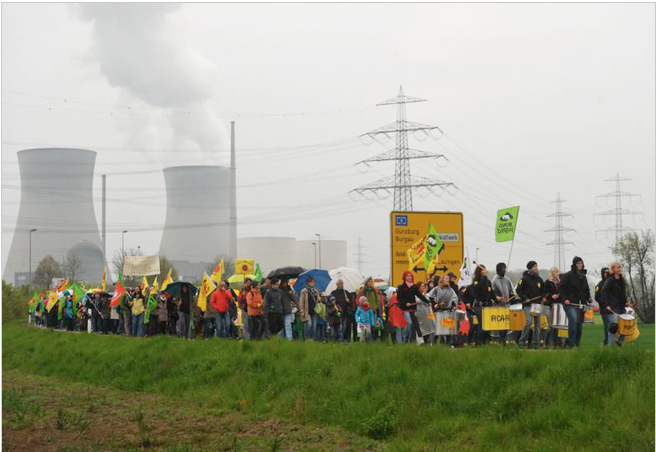
Demonstration Gundremmingen April 23, 2016
„Shut down nuclear reactors
before the next major accident happens!!“
Address by Raimund Kamm (abridged)
Why are we here today?
Four days of commemoration for warning.
50 years Gundremmingen NPP
In 1966 unit A of this NPP went critical for the first time. Two boiling water reactors (BWRs) are still in service. There used to be ten BWRs operating in all of Germany. Eight of them have been shut down for good. The ones right here are the only ones still active – and they are a dreadful menace.
BWRs were cheaper to build than the more numerous pressurized water reactors (PWRs). However, the margin of error in BWRs is much reduced. Also, the reactor pressure vessels of the two BWRs at Gundremmingen suffer from a design flaw. An important weld is situated at a quite delicate position. Should a major pressure shock wave arise the welds could rupture. Furthermore, Gundremmingen is not sufficiently equipped with emergency cooling systems. Because of this, experts like professor Renneberg or Dr Mertins hold that the continued operation of the plant is not in compliance with its license. Therefore the Bavarian Government as the regulating body should step in to revoke the license.
30 years Chernobyl. On April 26, 1986, Chernobyl’s reactor 4 exploded. Operator error and construction defects were cited as causes for the catastrophe. Dozens of people died immediately. Tens of thousands of young soldiers were ordered on site to fight the horrendous radiation.
(………)
10 years of intermediate storage at Gundremmingen. In August 2006 Germany’s biggest intermediate storage site was inaugurated. It is insufficiently hardened against terrorist attacks. As of today it is highly likely that it will still be in use by the end of the century.
(………)
5 years since Fukushima. Triggered by an earthquake and a tsunami on March 11, 2011, three BWRs and a fuel pool explode in Fukushima. At a closer look the root cause for the disaster has to be attributed to the interplay of incredible design errors (however, these were only known to the experts) and the stupefying carelessness of TEPCO and the authorities, exacerbated by corruption – an issue frequently associated with nuclear energy projects.
A change is possible! We are here to demand this change loud and clear.
In Germany, excess capacity in power generation is such that Gundremmingen NPP could be shut down instantly. The other six legacy reactors could then follow in short order.
Here and now our five demands are:
1. Germany’s most dangerous power plant, Gundremmingen NPP, has to be shut down as soon as possible. Both units have to be phased out by 2017 at the very latest.
2. Scientific criteria must prevail and a transparent process applied in order to locate the most suitable site for the construction of a deep geological repository. The repository must then be built on that location.
3. More robust structures have to be put up in order to accommodate intermediate storage as they will likely be in use for decades. These installations do not necessarily have to be in the vicinity of NPPs…
4. First steps should be undertaken to terminate the use of coal in order to protect public health and combat climate change.
5. The brisk expansion of photovoltaic and land based wind power is to be continued. Current low targets for further development and the Bavarian 10-H-rule (10-H-Regelung) is to be revoked.
(…………….)
The struggle will go on.
Shut down now!
Raimund Kamm
Looking back on the “nuclear year“ of 2015
The nuclear dangers in Gundremmingen are rising – but the worldwide revival of nuclear power did not happen fortunately!![]()
If we take a look back to the year 2015, we can see that the dangers resulting from nuclear power are increasing. However, we can also see that the use of renewable energies has been increasing worldwide since they obviously have several benefits. But both nuclear risks as well as climate change are rather abstract concepts for most people. That`s why we have to keep discussing and debating them.
Germany`s biggest and most dangerous power plant delivered a large amount of energy in the year 2015 – and it produced an enormous amount of nuclear waste. Two serious incidents demonstrated that this nuclear reactor is close to its expiry date. However, despite of all the considerations in favour of nuclear energy, a new nuclear boom did not occur in 2015. On the contrary, the number of photovoltaic arrays and wind turbines is rising.
8 February 2016 Raimund Kamm
08.02. 2016, Raimund Kamm [mailto:r.kamm@anti-akw.de]
Highly dangerous temporary storage of nuclear waste in Gundremmingen for another 50 years.
Those people who live next nuclear waste storage sites – it is us, the local population – have this problem literally in our back yards. We can imagine what our children and grandchildren will have to face if this lethal radioactive waste remains in the temporary storage facilities above ground. Unfortunately we have heard from the Berlin Final Storage Commission that there will be no final storage facility in this century!
Süddeutsche Zeitung, December 11, 2015, Bavaria
![]()
Gundremmingen: Germany’s Most Hazardous Nuclear Site
The Swabian nuclear power plant Gundremmingen is the most hazardous nuclear installation in the country. As reported by Der Spiegel (Dec 11, 2015) this is the conclusion drawn by a current analysis of the federal Gesellschaft für Anlagen- und Reaktorsicherheit (GRS, a federal association for the promotion of safety in nuclear installations). The verdict was reached after investigators had evaluated so-called precursor incidents: incidents which could – in a worst case scenario – progress into a full-blown core meltdown. The NPP near Ulm, host to two reactor units, is leading this statistic with 14 dysfunctions recorded. All of the other six remaining NPPs in Germany combined registered only 10 of such incidents. The report covered events from 1993 up to 2010. To skeptical nuclear experts this result is hardly surprising. They have long since considered Gundremmingen to be the most dangerous NPP in the nation. Thus their appraisal has now been officially validated.
Raimund Kamm, chief executive of FORUM Gemeinsam gegen das Zwischenlager und für eine verantwortbare Energiepolitik e. V. (the registered association Together Against Intermediate Storage and for a Conscientious Energy Policy) comments:
We are very concerned about the following issues:
– Only at Gundremmingen the boiling water reactor design is still in use:
– in contrast to pressurized water reactors this type has only a single main cooling circuit
– The control rods, which are essential to shutting the reactor down, have to be injected into the reactor from below, against the force of gravity.
– The delicate spent fuel pool is precariously situated outside of containment
– In Germany, only at Gundremmingen are there two units operating side by side, thereby putting each other at risk.
– If measured by radioactivity, more nuclear waste is stored in Gundremmingen than at any other site in Germany
– Both containments at Gundremmingen are of deficient design and could not be licensed today
– There is no proof that Gundremmingen could withstand the intentional or accidental impact of an aircraft without releasing radioactivity into the environment
– The intermediate storage facilities at Gundremmingen are not hardened against terrorist attack
– The NPP has now been operating for an astonishing 49 years – while waste clean-up remains elusive!
Süddeutsche Zeitung Dec. 7, 2015 21:32 By Wolfgang Wittl http://www.sueddeutsche.de ![]()
Bavaria is clearing the way for dry storage casks
After a protracted battle the leader of the CSU, Horst Seehover, finally caves in – very much to the chagrin of the districts affected
Bavaria has been the last of Germany’s federal states to assent to taking delivery of dry storage casks* which had originally been earmarked for the intermediate storage site at Gorleben. Therefore, seven of a total of 26 dry casks expected to arrive in the course of the coming years from reprocessing installations in France and the UK are to be sent back to the Isar nuclear power plant. According to an agreement between Bavaria’s Prime Minister Horst Seehofer (CSU) and the federal Minister for the Environment Barbara Hendricks (SPD) this is treated as “an issue of national importance in which Bavaria is prepared to honor its share of responsibility”. Süddeutsche Zeitung is in possession of a copy of this agreement.
Originally the dry casks had been planned to be sent to the intermediate storage facility at Gorleben. However, the state of Lower Saxony has successfully inserted a clause into the accord concerning the renewed search for a final disposal site that precludes any further shipping of dry casks to the Wendland site. This course of action pursued by the state government was intended to foreclose any precedent in favor of the local salt dome – for decades the location had been the primary candidate to host a final storage site. The wrangling has been ongoing ever since.
The concession by Bavaria allows the agreement to go forward as negotiated by Hendricks with the companies operating NPPs during the summer. The companies will have to file appropriate requests; only thereafter the allotment of the 26 dry casks can be initiated. Originally four sites were designated to receive the casks: Brokdorf in Schleswig-Holstein, Biblis in Hesse, Philippsburg in Baden-Württemberg and, finally, Bavaria. The first casks will arrive in 2017 at the earliest; they contain the residues of spent fuel elements after reprocessing.
At the outset, Bavaria had put up fierce resistance. Marcel Huber (CSU), Head of the State Chancellery, had been chastising the proposal as “politically unwise and brazen”. If the federal government was intent on moving forward unilaterally he “was prepared to question the turnaround in national energy policy [die Energiewende] as a whole”. According to Mr Huber everything was interconnected.
Storage is to be approved by mid-2016
The local District Administrator Peter Dreier (Freie Wähler) is on record as declaring that “this decision is incomprehensible for a good number of citizens and local officials”. To dismiss Gorleben in favor of four sites strewn across the country meant to inflict grave harm on the national economy. “We are going to critically monitor the process” Dreier announced. Furthermore, the district might move to examine the case for legal action.
Nevertheless, with the agreement standing, at the site of the NPP everything is supposed to be speedily brought in line. By mid-2016 the storage of vitrified wastes is planned to be authorized at Isar NPP, the paper asserts. The intermediate storage facilities themselves will have to be recertified, they are supposed to be “hardened” in preparation for the new wastes. Licenses are planned to be issued by next winter.
(Article abridged)
* In Germany these specialized containers are commonly known as CASTOR, an acronym used as a brand name by their producer GNS Gesellschaft für Nuklear-Service mbH: cask for storage and transportation of radioactive material.
Worrying incident at the nuclear power plant Gundremmingen
On Thursday, November 5, 2015 a serious incident occurred at Gundremmingen NPP. During the repositioning of spent fuel elements in the fuel pool of unit C the head of a fuel bundle broke free. Allegedly the fuel rods stayed intact and none of the fission products were released. I have never heard of a similar occurrence. News of the incident was released on Friday, November 6. I immediately sent the questions listed below to a number of experts and asked them to kindly comment on the event. As of today [November 11] only Wolfgang Neumann replied.
Probably the implications of the incident are being underestimated. In the following some background information:
A fuel element as used by the reactor type at Gundremmingen normally consists of a bundle of 100 fuel rods. These fuel rods are more than 4 meters in length and comparable to a finger in thickness. They look like a gigantic stack of tablets sleeved in a tube. The uranium pellets inside the tubes may be MOX or reprocessed uranium pellets. As long as the fission process has not been initiated, the radiation can be blocked very effectively.
This is what a fuel element looks like:
Some information about spent fuel pools was published on the information and propaganda web pages of the energy companies after the Fukushima catastrophe [in German]: http://www.google.de/imgres?imgurl=http%3A%2F%2Fwww.energie-fakten.de%2Fhtml-neu%2Fjapan%2F2011-03-brennstab-neu.jpg&imgrefurl=http%3A%2F%2Fwww.energie-fakten.de%2Fhtml%2Ffukushima-2-roth.html&h=283&w=500&tbnid=Z-tlxhWkKIo-AM%3A&docid=BEzOWV6udwXivM&hl=de&ei=3wpDVpnPIcyvsQGRh4nYAg&tbm=isch&iact=rc&uact=3&dur=1617&page=1&start=0&ndsp=20&ved=0CDYQrQMwAWoVChMI2bqm5YeIyQIVzFcsCh2RQwIr
One gram is capable of radioactively contaminating entire regions
The Chernobyl accident revealed the unbelievably high radiotoxicity contained in the fuel rods. Back then lawn clippings and hay had to be “disposed of”, playgrounds and sand boxes had to be closed down. The fall out was intensified by rain around Berchtesgaden and across the Bavarian Forest, peaking in the area around Augsburg. Distance Chernobyl – Augsburg: 1400 km as the crow flies.
All of this was caused by one gram of Iodine-131 that had descended on the former Federal Republic of Germany (FRG). By just one gram. I-131 has a half-life of 8 days, so it has long since decayed and is now gone. Half-life describes the length of time it takes for half of the radioactive element to decay and thus “disappear”. Even today most wild boars are heavily contaminated. This is caused by a different nuclide created by the fission of uranium: Cesium 137, which has a half-life of 30 years. About 230 grams have been blown over the FRG and were washed out by rain (Source: Bundesamt für Strahlenschutz: “Tschernobyl – 30 Jahre danach”, page 9). The greatest portion of the spent fuel elements have been in the fuel pool for many years, therefore, Iodine 131 has already vanished. However, many other nuclides, including Plutonium, will be there for centuries to come.
We ask our representatives in the Bayrische Landtag (State Diet of Bavaria) that the Bavarian State Government, which is responsible for nuclear oversight, will request a report on the incident at Gundremmingen.
Media release from Nov. 6, 2015
Worrying incident at the Gundremmingen NPP
During the repositioning of spent fuel elements in the fuel pool of unit C the head of a fuel bundle broke free. This information was made public today, as Gundremmingen NPP issued a news flash. For an appraisal of the significance of this event the following important questions must be answered:
1. Has there been any leakage from the fuel rods?
2. How much radioactivity does the fuel element contain? We fear it might be quite a lot and actually amount to some percent of the long term radioactivity released by Chernobyl?
3. Has a similar event ever been recorded in another German NPP?
4. What company in which country built the fuel element? Is a uranium fuel element, a MOX element or a reprocessed uranium element implied?
5. For how long had this fuel element been in the fuel pool? As is widely known, spent fuel elements are supposed to remain in the pool for five years only. However, according to rumors at Gundremmingen some of the fuel elements have been languishing in the pool for up to twenty years?
6. Are these fuel elements mechanically so fragile, that such incidents were anticipated or did the usage within the reactor and the long period in the fuel pool facilitate the fracture?
Raimund Kamm (Vorstand) FORUM Gemeinsam gegen das Zwischenlager und für eine verantwortbare Energiepolitik e.V.
Augsburg – Dillingen – Günzburg – Heidenheim – Ulm
Nuclear Power Plants in Germany
Raimund Kamm, September 2015
(Photo: SWP Ulm) NPP Gundremmingen, 30 km downstream from the city of Ulm. Leading up to the plant is a cooling canal fed by the Danube. The river is visible in the background to the left. In the foreground, painted white, are the two boiling water reactor buildings, which are flanked on the right by the temporary waste storage hold.)
Eight remaining
In the autumn of 2015 eight of the major legacy reactors are still in operation. Three are located in Northern, five in the Southern part of Germany.
In terms of radioactivity every single one of these reactors produces one and a half times as much nuclear waste as is contained in the 126.000 waste barrels buried in the scandal ridden experimental depository of Asse. Since the start-up of the first reactors in the 1960s not even one kilogram of the waste produced by fissioning Uranium nuclei has been disposed of. This is an incredible crime against our offspring. All of this nuclear waste will have to be isolated and safely stored for a million years, only then will the deadly radiation finally have subsided!
Not one of the eight operating reactors is adequately insured – the rates would be prohibitive. This is because the risk of an accident is mathematically small (let’s hope it is!), but the resulting damages would be enormous.
21 down
21 major reactors (rated above 100MW electric) have already been shut down, the same is also true for some experimental reactors.
According to currently applicable nuclear law the remaining eight reactors are supposed to be shut down by 2022: Gundremmingen B (2017), Philippsburg 2 (2019), Gundremmingen C (2021), Grohnde (2021), Brokdorf (2021), Emsland/Lingen (2022), Neckarwestheim 2 (2022), Isar 2 (2022).
This process can and must be expedited
In view of the risk, in view of unsolved problems concerning nuclear waste, in view of higher-than-average numbers of children suffering from cancer in the vicinity of NPPs we environmentalists demand the shut-down of those plants as soon as it can possibly be done. On paper and with great effort we could accomplish the feat in a matter of days. Unfortunately this course of action would also necessitate the increased use of gas- and coal-fired power plants that are harming our climate. However, the perfectly viable increase of energy efficiency combined with an ambitious expansion of wind and photovoltaic power would make our goal absolutely feasible. As an accompanying measure we need to adapt and expand our power grid, refine our power management and invest in new storage technologies.
Raimund Kamm (Diplomökonom) Kamm@gmx.de

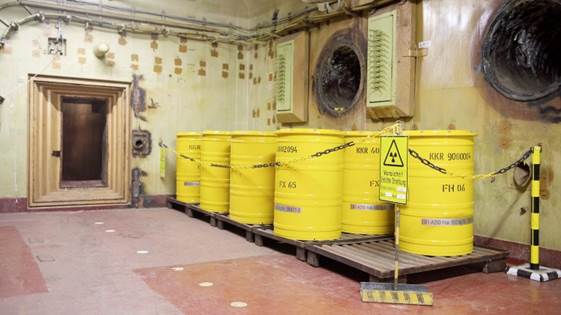
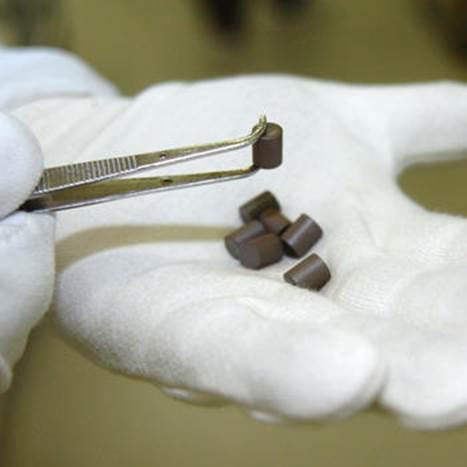
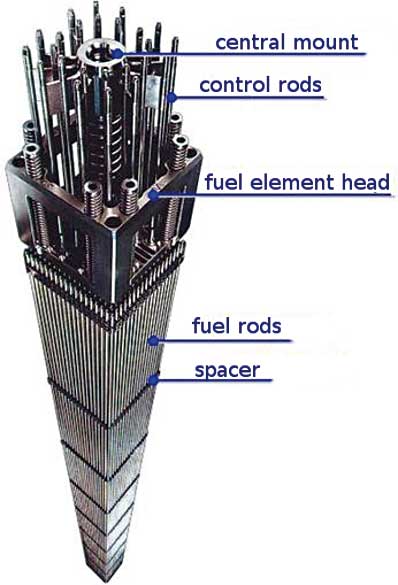
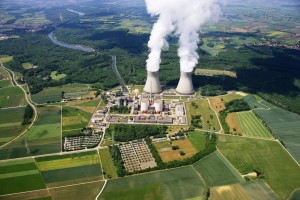
Off